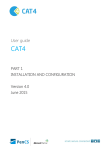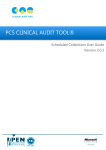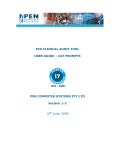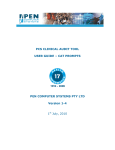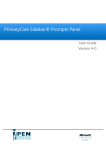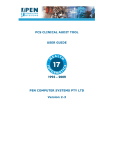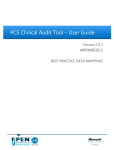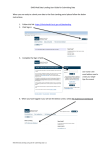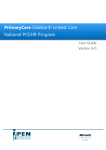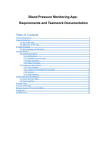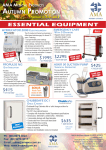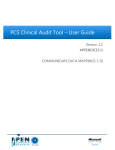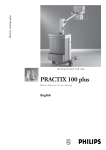Download PCS Clinical Audit Tool – User Guide
Transcript
PCS Clinical Audit Tool – User Guide Version 3.4 PART 1 INSTALLATION AND CONFIGURATION PCS Clinical Audit Tool – User Guide – Part 1 INSTALLATION & CONFIGURATION Version 3.4 Company Contacts Sydney (Head Office) Pen Computer Systems Level 6, The Barrington Document Contact Contact: Project Officer 10-14 Smith St PARRAMATTA NSW 2150 Phone: +61 2 9635 8955 Fax: +61 2 9635 8966 Email: [email protected] Web: www.pencs.com.au Christine Chidgey Phone: +61 3 9866 8477 Email: [email protected] Melbourne Office Pen Computer Systems Level 5 434 St Kilda Rd MELBOURNE VIC 3004 Phone: +61 3 9866 8477 Fax: +61 3 9866 5699 13 June 2012 PAGE 2 of 33 PCS Clinical Audit Tool – User Guide – Part 1 INSTALLATION & CONFIGURATION Version 3.4 Document Control Version Date Modified By Description 2.4 16/02/2009 Christine Chidgey Initial Document for Installation and Configuration instructions. The CAT User Guide has been split into 2 parts – this is Part 1. 2.4.1 26/03/2009 Christine Chidgey Updates for • changes to login screen and license key information • configuration of Billing Software – available for MD users with Pracsoft3 2.5 28/05/2009 Christine Chidgey No changes this release 2.5.1 23/06/2009 Christine Chidgey Updates for new logos on screens 2.5.2 20/07/2009 Christine Chidgey Add Zedmed compatibility 2.6 12/10/2009 Christine Chidgey No changes this release 2.7 30/11/2009 Christine Chidgey No changes this release 2.8 09/02/2010 Christine Chidgey Update document template. No changes this release. 2.9 17/05/2010 Christine Chidgey Updates to System Requirements: • .NET 2.0 SP2 • Increased memory is required for very large database • ‘Send Data To’ email function requires a mail client to be installed 2.9.3 17/08/2010 Christine Chidgey Updates to Best Practice configuration and preferences – a password is now required to be set 2.10 06/09/2010 Christine Chidgey Best Practice billing configuration 2.11 04/01/2011 Christine Chidgey Add practiX compatibility Disclaimer added on login to new update 2.12 27/07/2011 Christine Chidgey Add Communicare compatibility 3.1 02/11/2011 Christine Chidgey 3.4 12/06/2012 Christine Chidgey 13 June 2012 Add Medinet compatibility CAT v3 requires pre-requisite of Microsoft .NET Framework 3.5 SP1 Update install link and associated screen shots Add Best Practice and Pracsoft compatibility Add MedTech32 configuration PAGE 3 of 33 PCS Clinical Audit Tool – User Guide – Part 1 INSTALLATION & CONFIGURATION Version 3.4 Contents COMPANY CONTACTS ............................................................................................................................................................. 2 Sydney (Head Office) ..................................................................................................................................................... 2 Melbourne Office .......................................................................................................................................................... 2 DOCUMENT CONTACT ............................................................................................................................................................ 2 CONTENTS .....................................................................................................................................................................4 1 INTRODUCTION ......................................................................................................................................................6 1.1 1.2 1.3 1.4 1.5 2 SYSTEM REQUIREMENTS ........................................................................................................................................8 2.1 2.2 2.3 2.4 2.5 2.6 2.7 2.8 2.9 2.10 2.11 2.12 2.13 2.14 2.15 2.16 3 OPERATING SYSTEM ................................................................................................................................................... 8 MICROSOFT .NET FRAMEWORK ................................................................................................................................... 8 INTERNET EXPLORER ................................................................................................................................................... 8 INTERNET CONNECTION .............................................................................................................................................. 9 MEMORY ................................................................................................................................................................. 9 DISK SPACE............................................................................................................................................................... 9 MAIL CLIENT ............................................................................................................................................................. 9 CLINICAL DESKTOP SYSTEM COMPATIBILITY................................................................................................................... 10 BILLING SYSTEM COMPATIBILITY ................................................................................................................................. 10 BEST PRACTICE REQUIREMENTS .................................................................................................................................. 11 GENIE REQUIREMENTS .............................................................................................................................................. 12 ZEDMED REQUIREMENTS ........................................................................................................................................... 12 PRACTIX REQUIREMENTS ........................................................................................................................................... 12 COMMUNICARE REQUIREMENTS ................................................................................................................................. 13 MEDINET REQUIREMENTS ......................................................................................................................................... 13 MEDTECH32 REQUIREMENTS .................................................................................................................................... 13 INSTALLATION ......................................................................................................................................................14 3.1 3.2 3.3 3.4 3.5 4 CLINICAL AUDIT TOOL (CAT) ....................................................................................................................................... 6 USER GUIDE ............................................................................................................................................................. 6 NOTES ABOUT THIS USER GUIDE ................................................................................................................................... 7 DEFINITIONS, ACRONYMS AND ABBREVIATIONS ................................................................................................................ 7 RELATED DOCUMENTS ................................................................................................................................................ 7 INSTALLING TO A DESKTOP PC .................................................................................................................................... 17 INSTALLING TO TERMINAL SERVICES OR CITRIX ............................................................................................................... 17 PROXY SERVERS ....................................................................................................................................................... 18 USING CLINICAL AUDIT OFFLINE ................................................................................................................................. 19 CAT LICENSE TOKEN ................................................................................................................................................ 19 CONFIGURATION .................................................................................................................................................20 4.1 SETTING YOUR PREFERENCES ..................................................................................................................................... 21 4.1.1 Choosing your Clinical Desktop System ....................................................................................................... 22 4.1.2 Choosing a preferred Data Extract Directory .............................................................................................. 27 4.1.3 Choosing and configuring your Billing System ............................................................................................ 28 5 CAT USER INTERFACE ...........................................................................................................................................31 13 June 2012 PAGE 4 of 33 PCS Clinical Audit Tool – User Guide – Part 1 INSTALLATION & CONFIGURATION 5.1 6 NAVIGATING THE CAT USER INTERFACE ....................................................................................................................... 31 COLLECTING DATA SETS .......................................................................................................................................32 6.1 6.2 6.3 7 Version 3.4 WHAT DATA IS COLLECTED ......................................................................................................................................... 33 HOW IS THE DATA STORED ......................................................................................................................................... 33 EXISTING DATA SET COMPATIBILITY WITH CHANGES TO CAT ............................................................................................. 33 DATA FILTERING AND DATA SET ANALYSIS ..........................................................................................................33 13 June 2012 PAGE 5 of 33 PCS Clinical Audit Tool – User Guide – Part 1 INSTALLATION & CONFIGURATION Version 3.4 1 Introduction 1.1 Clinical Audit Tool (CAT) The Clinical Audit Tool (CAT) analyses clinical information from GP Clinical Desktop Systems. It translates data into real statistical and graphical information that is easy to understand and action. This allows practitioners to assess and improve the quality and completeness of patient information. The benefit to the practice is to assist with its ongoing accreditation and provide opportunities to grow practice income. The emphasis of the tool is to help practice staff to take specific action to improve patient coverage in chronic disease management and prevention. Other benefits of CAT are many and include: • targeting patients with particular needs • targeting patients with specific health risk profiles • improved compliance with statistical data collections • extracting data to meet the needs of others • meeting reporting requirements Statistics that are required for the Australia Primary Care Collaboratives (APCC) program and the DoHA Future Directions Key Performance Indicators for Divisions are a by-product of the use of the system. 1.2 User Guide The purpose of this document is to provide instructions on how to install and use the functionality provided by the CAT. This manual is split into 2 parts: Part 1: Installation and Configuration including how to collect data sets Part 2: Functionality 13 June 2012 PAGE 6 of 33 PCS Clinical Audit Tool – User Guide – Part 1 INSTALLATION & CONFIGURATION Version 3.4 1.3 Notes about this User Guide This User Guide describes the use of the PCS Clinical Audit Tool with reference to the HCN Medical Director, Best Practice and Genie Clinical Desktop Systems. Wherever Medical Director is used in this document we are referring to the Health Communications Network – Medical Director ™ Clinical Desktop System. Wherever Best Practice is used in the document we are referring to the Clinical Desktop System produced by Best Practice Software. Wherever Genie is referred to we are referring to the Clinical Desktop System produced by Genie Solutions. Wherever Zedmed is referred to we are referring to the Clinical Desktop System produced by Zedmed Medical Software Solutions. There are other Clinical Desktop Systems that may interoperate with the PCS Clinical Audit Tool in the future and additions will be made to this User Guide when they are available. 1.4 Definitions, acronyms and abbreviations Term CAT Description Clinical Audit Tool MD Medical Director PCS Pen Computer Systems RACGP Royal Australian College of General Practitioners 1.5 Related Documents ‘PCS Clinical Audit Tool – User Guide Part 2 – Functionality’ This User Guide provides instructions on how to use install and configure CAT. This guide is available from http://help.pencs.com.au/cat.htm 13 June 2012 PAGE 7 of 33 PCS Clinical Audit Tool – User Guide – Part 1 INSTALLATION & CONFIGURATION Version 3.4 2 SYSTEM REQUIREMENTS The minimum and recommended system requirements to be able to run the Clinical Audit tool are provided in this section. 2.1 Operating System Clinical Audit runs under the following environments (maintained to latest Microsoft patch levels); Microsoft Windows VISTA Microsoft Windows XP Microsoft Windows 2003 Server Microsoft Windows 2003 R2 Server Microsoft Windows 2008 Microsoft Windows 7 2.2 Microsoft .NET Framework PCS Clinical Audit version 3 requires the Microsoft .NET Framework version 3.5 SP1 to be installed prior to installing PCS Clinical Audit. This can be downloaded from the Microsoft website. Practices should contact their IT administrator if this is not already installed. How to check which version of .NET you have installed: Go to Start > Control Panel Open ‘Add or Remove Programs’ Check to see that ‘Microsoft .NET Framework 3.5 Service Pack 1’ appears in the list 2.3 Internet Explorer To install PCS Clinical Audit you must use Internet Explorer version 5.5 or later. Clinical Audit can be installed by going to the following URL http://install.pencs.com.au/ClickOnce/ClinicalAudit/publish.htm 13 June 2012 PAGE 8 of 33 PCS Clinical Audit Tool – User Guide – Part 1 INSTALLATION & CONFIGURATION Version 3.4 2.4 Internet Connection PCS Clinical Audit uses an authentication mechanism that requires a persistent internet connection. It is recommended that you have a broadband internet connection to operate PCS Clinical Audit. 2.5 Memory Clinical Audit requires at least 196MB of available memory for a typical Clinical Desktop System installation (eg. Medical Director with approximately 10,000 patient records). It is recommended that you use Clinical Audit on a system with at least 512MB of RAM installed. Very large databases will require more RAM. It is recommended practices inactivate patients who are no longer attending the practice as the extract process only runs over active patients. 2.6 Disk Space The program itself is relatively small; however, each snapshot for a typical Clinical Desktop System (eg. Medical Director) installation1 will require around 25MB of disk space. 2.7 Mail Client If you will be using the CAT ‘Send Data To’ email function you will need to have a mail client installed on the PC you are sending from. 13 June 2012 PAGE 9 of 33 PCS Clinical Audit Tool – User Guide – Part 1 INSTALLATION & CONFIGURATION Version 3.4 2.8 Clinical Desktop System Compatibility Clinical Audit is compatible with the following clinical application and versions. As new versions are released, PCS Clinical Audit will be validated and, if required, updated to maintain compatibility. • Medical Director Clinical Audit is compatible with Medical Director Versions 2 and 3. • Best Practice Clinical Audit is compatible with Best Practice version 1.6.0.395 and later. • Genie Clinical Audit is compatible with Genie Version 7.5.3 and later. • Zedmed Clinical Audit is compatible with Zedmed Version 11 and later. • practiX Clinical Audit is compatible with practiX Version 1.36 build 2 and later. • Communicare Clinical Audit is compatible with Communicare Version 11.2 and later. • Medinet Clinical Audit is compatible with Medinet Version released July 2011 and later. • MedTech32 Clinical Audit is compatible with MedTech32 Version 8.1 and later. 2.9 Billing System Compatibility Billing is compatible when the clinical and billing systems are provided by the same vendor and the data extract for the clinical system is version 1_5 or above. Currently the following billing is supported: • MD2 or MD3 and Pracsoft • BP and BP Management • practiX • Communicare • Zedmed • MedTech32 13 June 2012 PAGE 10 of 33 PCS Clinical Audit Tool – User Guide – Part 1 INSTALLATION & CONFIGURATION Version 3.4 2.10 Best Practice Requirements Best Practice Software data extract requires that a database browser password is configured. This password is set in Best Practice and must be entered in the Clinical Audit Tool Preferences. In Best Practice: • Select Setup > Configuration from the top menu bar. • Select the ‘Database’ option from the left hand tool bar • Click the ‘Database browser’ button • Enter and confirm a password of your choice • If a password has previously been configured you will be required to enter the current password as well NOTE: If a password has been configured and you do not know what it is you will need to contact Best Practice Support for assistance. \ In Clinical Audit: • Enter the password you have set up in the CAT Best Practice Preferences. Refer to the section in this document ‘Setting Your Preferences’. 13 June 2012 PAGE 11 of 33 PCS Clinical Audit Tool – User Guide – Part 1 INSTALLATION & CONFIGURATION Version 3.4 2.11 Genie Requirements The Genie software application provides a new Reports menu option that performs the data extraction for Clinical Audit. The data extraction process is described in the Genie Mappings document available from http://help.pencs.com.au/cat.htm. 2.12 Zedmed Requirements Zedmed provides an executable file (PenDataExtract.exe) that must exist in your local Zedmed installation directory in order for Clinical Audit to be able to collect data. The local Zedmed installation directory is usually C:\Zedmed or C:\Patients. If this file is not installed you will receive the following error message when you click the Clinical Audit ‘Collect’ button. If you receive this message you can download the executable file from http://help.pencs.com.au/cat.htm > click on the CAT Zedmed extractor link. Updates to the extractor are available from this link. 2.13 practiX Requirements The practiX software application requires practiX Support to upgrade the practiX application to provide the Custom PENEXTRACT Administration option. The data extraction process is described in the practiX Mappings document available from http://help.pencs.com.au/cat.htm. 13 June 2012 PAGE 12 of 33 PCS Clinical Audit Tool – User Guide – Part 1 INSTALLATION & CONFIGURATION Version 3.4 2.14 Communicare Requirements Communicare provides an executable file (ccCATExport.exe) that must exist in your local Communicare installation directory in order for Clinical Audit to be able to collect data. The local Communicare installation directory is usually C:\Program Files\Communicare. If this file is not installed you will receive the following error message when you click the Clinical Audit ‘Collect’ button. If you receive this message contact Communicare for assistance. 2.15 Medinet Requirements The Medinet software application provides a new Reports menu option that performs the data extraction for Clinical Audit. The data extraction process is described in the Medinet Mappings document available from http://help.pencs.com.au/cat.htm 2.16 MedTech32 Requirements MedTech32 provides an executable file (MT2PenCAT.exe) that must exist in a special MedTech32 CAT extractor installation directory in order for Clinical Audit to be able to collect data. The installation directory is usually C:\Program Files\Medtech Global Limited\MT2PENCAT. If this file is not installed you will receive the an error message when you click the Clinical Audit ‘Collect’ button advising the file is missing. If you receive this message contact MedTech32 for assistance. 13 June 2012 PAGE 13 of 33 PCS Clinical Audit Tool – User Guide – Part 1 INSTALLATION & CONFIGURATION Version 3.4 3 INSTALLATION The Clinical Audit Tool is available using Microsoft ClickOnce technology. Using Internet Explorer and go to the URL http://install.pencs.com.au/clickonce/clinicalaudit/publish.htm Note: ClickOnce technology is not compatible with FireFox. Click the ‘Install’ button The application will be launched. 13 June 2012 PAGE 14 of 33 PCS Clinical Audit Tool – User Guide – Part 1 INSTALLATION & CONFIGURATION Version 3.4 A dialog box will display showing you the progress of the install. Once the install has completed the Clinical Audit Tool Login screen will appear. Username and Password – enter the details provided to you. Click ‘Ok’ 13 June 2012 PAGE 15 of 33 PCS Clinical Audit Tool – User Guide – Part 1 INSTALLATION & CONFIGURATION Version 3.4 The first time you login the Default Data Directory dialog box below will pop up. This lets you know that the folder ‘C:\ClinicalAudit’ on your PC will be used to store the ‘snap-shots’ of your data for analysis by the Clinical Audit Tool. If you prefer to store them somewhere else you can change this by selecting Edit > Preferences from the top menu. Setting your preferences is explained in the next section: ‘Setting Your Preferences’. Click ‘Ok’ Each time you install a new update of Clinical Audit a Disclaimer dialogue box will be displayed. Tick that you accept the disclaimer (the ‘OK’ button will become active) Click ‘OK’ to continue or ‘Cancel’ Each time you install a new release of Clinical Audit a Release Notes dialogue box will be displayed. Click ‘OK’ to continue 13 June 2012 PAGE 16 of 33 PCS Clinical Audit Tool – User Guide – Part 1 INSTALLATION & CONFIGURATION Version 3.4 3.1 Installing to a Desktop PC Clinical Audit needs to be installed under each profile (login) that will be using it on the PC. That is, if multiple people log on to the one PC and they each want to use Clinical Audit the installation needs to be repeated for each login. The application generally only installs once but ‘activates’ itself for the other logins on additional installs. 3.2 Installing to Terminal Services or Citrix The only differences to the preceding installation instructions are the following: 1. Clinical Audit needs to be installed on the SERVER • Log on as the user via a Terminal Services or Citrix session and you will automatically be on the server. Follow the installation instructions in the preceding section. 2. Clinical Audit needs to be installed under each profile (login) that will be using it. That is, if multiple people will be using it, the installation needs to be repeated for each login. The application generally only installs once but ‘activates’ itself for the other logins on additional installs. • Log on as each user that will be using CAT and repeat the install instructions. NOTE: If access privileges are an issue, then you will need to elevate the user’s privileges to install and then restore them afterwards. This is a Microsoft configuration. 13 June 2012 PAGE 17 of 33 PCS Clinical Audit Tool – User Guide – Part 1 INSTALLATION & CONFIGURATION Version 3.4 3.3 Proxy Servers If you are having trouble installing the Clinical Audit Tool it may be because you a behind a Proxy Server. Some Proxy Servers will prevent you from installing the Clinical Audit Tool which uses a very new deployment technology developed by Microsoft. When attempting to install one of the following may occur • you get a message like “the application failed to install” • you get a message indicating a “CGI error” • you can’t login even though you have the correct user name and password These problems are most likely caused by your system’s Proxy Server. If you cannot install the Tool, please contact your Network Administrator or IT support person and advise them of this issue. There is a hot-fix supplied by Microsoft that may help in allowing installation to occur behind your Proxy Server. The hot-fix can be downloaded here: http://www.myhealthepractice.com.au/DOTNETHOTFIX_Proxy_KB917952.zip If your Network Administrator or IT support contact is unable to help please contact your division. Follow these steps 1. 13 June 2012 Logon to the computer you are installing CAT onto as Administrator 2. Download the zip file and extract the files 3. Run the extracted .exe file 4. Reboot the computer PAGE 18 of 33 PCS Clinical Audit Tool – User Guide – Part 1 INSTALLATION & CONFIGURATION Version 3.4 3.4 Using Clinical Audit Offline You must install and login initially to Clinical Audit while connected to the Internet so your login details can be validated. You can then use CAT without being connected to the Internet for a period of 1 month. When you are connected to the Internet CAT is able to verify your registration credentials are still valid and check to see if there are any application updates available for download. If you use CAT for a long period of time without connecting to the Internet then your credentials will eventually expire. You will need to connect again and go to the CAT installation URL to download an update. Note: If you have a Desktop Shortcut to CAT and it does not work offline you simply need to delete and recreate it. 3.5 CAT License Token When your registration credentials are validated a CAT license token is generated for you ‘behind the scenes’. This provides access to all the standard CAT functionality described in Part 2 of this manual: ‘PCS Clinical Audit Tool – User Guide Part 2 - Functionality’. Custom CAT modules may be developed to meet specific user requirements. License tokens can be issued to users that provide access to the standard functionality and the required additional modules. If you are provided with a custom license token you can enter this by 13 June 2012 • clicking the Help icon • clicking the ‘License Token’ button • pasting the license token into the License Token box. PAGE 19 of 33 PCS Clinical Audit Tool – User Guide – Part 1 INSTALLATION & CONFIGURATION Version 3.4 4 CONFIGURATION Once the CAT software has been installed it is available from your Programs List. Click Start > All Programs > Pen Computer Systems > PCS Clinical Audit Enter your Account name and Authorisation key and click ‘OK’. Once you have logged in the screen below will display. You will see the population figure is initially 0 because you have not yet collected data from your clinical desktop system. 13 June 2012 PAGE 20 of 33 PCS Clinical Audit Tool – User Guide – Part 1 INSTALLATION & CONFIGURATION Version 3.4 4.1 Setting Your Preferences Your Preferences are set by selecting Edit > Preferences from the top menu. The Preferences Dialog box will be displayed. GP Application From the drop down list select the Clinical Desktop System you wish to collect from. Then click the tab for that Clinical Desktop System to enter further values. Practice Name and Practice ID Number Fill in the values for these fields with your practice details. At a future time these values will be used if your practice decides to participate in projects that send consented, de-identified patient clinical data to your Division or other data repository. Extract Directory This folder is used to store the ‘snap-shots’ of your data for analysis by the Clinical Audit Tool. By default the data will be stored in the folder ‘C:\ClinicalAudit’ on your PC. If you prefer to store them somewhere else you can change this by clicking the ‘Browse’ button and choosing another Data Folder Location. Click ‘OK’ when you have selected a new location. Click ‘OK’ to save this location and close the Dialog box. Saved Filters Directory This folder is uses to store your saved filter criteria. Saved filters can be reloaded and run at a later time. Details are provided in the ‘PCS Clinical Audit User Guide Part 2’. 13 June 2012 PAGE 21 of 33 PCS Clinical Audit Tool – User Guide – Part 1 INSTALLATION & CONFIGURATION Version 3.4 4.1.1 Choosing your Clinical Desktop System Once you have selected your Clinical Desktop System from the ‘Clinical Audit’ tab, click the corresponding tab for that Clinical Desktop System to enter further configuration options. Eg. GP Application ‘Medical Director’ selected, now click the corresponding tab The options available for each system are explained in the following pages. Values will be defaulted where possible. Once you have selected and configured your Clinical Desktop system the details will be displayed above the row of tabs. Clinical Desktop System Database Location Medical Director users who are also using Pracsoft3 as their Billing software can configure their preferences to include Pracsoft3 and collect billing data as well as clinical data. This is explained further in the section 4.1.3. 13 June 2012 PAGE 22 of 33 PCS Clinical Audit Tool – User Guide – Part 1 INSTALLATION & CONFIGURATION Version 3.4 Medical Director 2 Click the browse button to locate the Database Directory. Medical Director 3 Select your Database Configuration from the drop-down list. These will match the configurations you have available through the ‘HCN Maintenance’ icon on your desktop. 13 June 2012 PAGE 23 of 33 PCS Clinical Audit Tool – User Guide – Part 1 INSTALLATION & CONFIGURATION Version 3.4 Best Practice Select either ‘Live Data’ or ‘Sample Data’ from the drop down list. Enter the BP Database Browser password that has been configured in BP. Genie There is no further set up for Genie. The Genie software application itself provides a new Reports menu option that performs the data extraction for Clinical Audit. This is described in the Genie Mappings document available from http://help.pencs.com.au/cat.htm. The Genie preference tab summarises the steps you should follow. Ensure the Extract Directory on the ‘Clinical Audit’ tab matches the extract folder chosen in Genie. Zedmed Browse to the local Zedmed installation directory. 13 June 2012 PAGE 24 of 33 PCS Clinical Audit Tool – User Guide – Part 1 INSTALLATION & CONFIGURATION Version 3.4 practiX There is no further set up for practix. The practiX software application itself provides a new Administration menu option that performs the data extraction for Clinical Audit. This is described in the practiX Mappings document available from http://help.pencs.com.au/cat.htm. The practiX preference tab summarises the steps you should follow. Ensure the Extract Directory on the ‘Clinical Audit’ tab matches the extract folder determined by practiX. Communicare Browse to the local Communicare installation directory. Enter your Communicare login details to allow automatic login to the exporter. Medinet There is no further set up for Medinet. The Medinet software application itself provides a new Resources menu option that performs the data extraction for Clinical Audit. This is described in the Medinet Mappings document available from http://help.pencs.com.au/cat.htm. The Medinet preference tab summarises the steps you should follow. Ensure the Extract Directory on the ‘Clinical Audit’ tab matches the extract folder determined by practiX. 13 June 2012 PAGE 25 of 33 PCS Clinical Audit Tool – User Guide – Part 1 INSTALLATION & CONFIGURATION Version 3.4 MedTech32 Select either ‘Live Data’ or ‘Sample Data’ from the drop down list. Browse to the MedTech32 CAT extractor installation directory. 13 June 2012 PAGE 26 of 33 PCS Clinical Audit Tool – User Guide – Part 1 INSTALLATION & CONFIGURATION Version 3.4 4.1.2 Choosing a preferred Data Extract Directory If there are a few clinicians in the practice that are using CAT then choose a network drive that is accessible to all. Use the ‘Edit > Preferences’ option to set the same ‘Extract Directory’ for each user. More than 1 user can work with the same snapshot at the same time. Genie/practiX users will need to make sure this folder matches the folder they select from the Genie/practiX application when they do the extract. This is described in the Appendices section of this manual. 13 June 2012 PAGE 27 of 33 PCS Clinical Audit Tool – User Guide – Part 1 INSTALLATION & CONFIGURATION Version 3.4 4.1.3 Choosing and configuring your Billing System The following billing is supported: • MD2 or MD3 and Pracsoft • BP and BP Management • practiX • Communicare • Zedmed • MedTech32 MD and BP users will need to configure their preferences for their Billing Software. MD2 and Pracsoft3 From the Medical Director 2 tab: • Choose ‘Pracsoft3’ from the Billing Software drop-down list • Go to the Medical Director 3 tab From the Medical Director 3 tab: • Choose the Database Configuration (this required because Pracsoft3 shares the same database as MD3 - this is the only MD3 field required) 13 June 2012 PAGE 28 of 33 PCS Clinical Audit Tool – User Guide – Part 1 INSTALLATION & CONFIGURATION Version 3.4 MD3 and Pracsoft3 From the Medical Director 3 tab: • Choose ‘Pracsoft3’ from the Billing Software drop-down list • The Document Server and Document Library should default correctly (these can be updated if required at a later date) 13 June 2012 PAGE 29 of 33 PCS Clinical Audit Tool – User Guide – Part 1 INSTALLATION & CONFIGURATION Version 3.4 BP and BP Management From the Best Practice tab: • Choose ‘Best Practice’ from the Billing Software drop-down list Best Practice and Pracsoft3 From the Best Practice tab: • Choose ‘Pracsoft3’ from the Billing Software drop-down list • Go to the Medical Director 3 tab From the Medical Director 3 tab: • Choose the Database Configuration (this required because Pracsoft3 shares the same database as MD3 - this is the only MD3 field required) 13 June 2012 PAGE 30 of 33 PCS Clinical Audit Tool – User Guide – Part 1 INSTALLATION & CONFIGURATION Version 3.4 5 CAT USER INTERFACE Once the CAT software has been installed it is available from your Programs List. • Click Start > All Programs > Pen Computer Systems > PCS Clinical Audit • Enter your Account name and Authorisation key and click ‘OK’. 5.1 Navigating the CAT User Interface Click the ‘View Extracts’ and the ‘View Filter’ buttons to display all the areas of the CAT user interface. The screen is divided into 3 sections: • Data Snap-shots (or Extracts) collected for analysis (Left Hand Panel) • Data Filters (Top Right Panel) • Data Reports (Bottom Right Panel) It is handy to be able to hide the data collection and data filter areas of the screen in order to make best use of your screen space to view the data results. You can toggle between the View/Hide modes at any time. Once you have logged in the screen below will display. You will see the population figure is initially 0 because you have not yet collected data from your clinical desktop system or loaded an existing extract file. 13 June 2012 PAGE 31 of 33 PCS Clinical Audit Tool – User Guide – Part 1 INSTALLATION & CONFIGURATION Version 3.4 6 COLLECTING DATA SETS NOTE: Before you start collecting data sets ensure you have set up your preferences to point to the correct clinical desktop system for your practice. (See ‘Setting Your Preferences’ for details about how to do this.) A data set is collected by clicking the ‘Collect’ button at the top left of the screen. Once you click the ‘Collect’ button you will see the ‘status bar’ in the top right hand corner of the screen flashing while the data is retrieved from the clinical desktop system. • Genie, practiX and Medinet users please note that the data collection is performed from within the your clinical application. Clicking the CAT ‘Collect’ button at the top left of the screen will provide you with the summary steps on how this is done within Genie. Step by step details are provided in the Appendices section of the ‘PCS Clinical Audit Tool User Guide Part 2’. The data set collected is saved in your preferred data folder (see ‘Setting Your Preferences’ for more information). When the data retrieval has completed you will see an entry in the left hand column. The data is stored as a ‘snap-shot’ on your PC. You can use this ‘snap-shot’ for analysis at any time in the future. Tip: To refresh the list of ‘snap-shots’ click Edit > Preferences and click ‘OK’. Each entry displays the date/time of collection, the number of records retrieved and the machine name on which the collection was done. You can collect as many data sets as you wish over time. Each data set will be listed as an entry in the left hand column. To analyse a specific data set click on the entry for that data set. It will become highlighted and you will see the ‘status bar’ in the top right hand corner of the screen flashing while the data is reloaded from the ‘snap-shot’ into Clinical Audit. 13 June 2012 PAGE 32 of 33 PCS Clinical Audit Tool – User Guide – Part 1 INSTALLATION & CONFIGURATION Version 3.4 6.1 What data is collected Data is only collected for patients who are active in your Clinical system. Data for patients who are deceased or have been made inactive is not collected unless it is required for reporting and the practice has set this option on (available MD/BP only) This means when you are analysing your data using CAT you are only seeing patients who are currently marked as active in your Clinical system. You may find patients in CAT that you know are no longer active at your practice. If you inactivate them in your Clinical system they will be excluded from future data collections. 6.2 How is the data stored The collect saves 2 xml data files to your preferred data folder. One file is pure Clinical data and has no identifiable patient information. This is called the DATA file. The other file is the LINK file and contains all the patient identifiable data. The LINK file is only used when you want to re-identify a list of patients that make up a segment of a graph. In your preferred data folder the files look like this: 6.3 Existing data set compatibility with changes to CAT CAT version 2 has new filters and reports. Additional data is collected by version 2 for these new functions. Your CAT version 1 extracts will not have the additional data needed to make these functions work. You can load up your version 1 extracts and analyse them as before - the new functionality will inactivated for these extracts by being greyed out. 7 DATA FILTERING AND DATA SET ANALYSIS These sections are included in the ‘PCS Clinical Audit User Guide Part 2’. 13 June 2012 PAGE 33 of 33


































